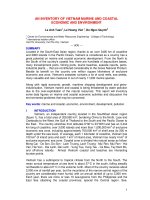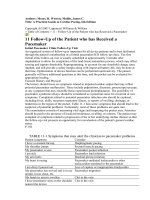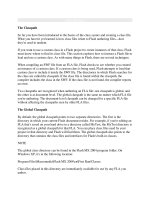Tài liệu The Effects of Childhood Stress on Health Across the Lifespan pptx
Bạn đang xem bản rút gọn của tài liệu. Xem và tải ngay bản đầy đủ của tài liệu tại đây (1.03 MB, 18 trang )
The Effects of Childhood Stress
on Health Across the Lifespan
U.S. Department of Health and Human Services
Centers for Disease Control and Prevention
The Effects of Childhood Stress on Health Across the Lifespan is a publication
of the National Center for Injury Prevention and Control of the Centers for
Disease Control and Prevention.
Centers for Disease Control and Prevention
Julie L. Gerberding, M.D., M.P.H., Director
Coordinating Center for Environmental
Health and Injury Prevention
Henry Falk, M.D., M.P.H., Director
National Center for Injury Prevention and Control
Ileana Arias, Ph.D., Director
Division of Violence Prevention
W. Rodney Hammond, Ph.D., Director
Authors
Jennifer S. Middlebrooks, M.S.W., M.P.H.
Natalie C. Audage, M.P.H.
Suggested citation: Middlebrooks JS, Audage NC. The Effects of Childhood
Stress on Health Across the Lifespan. Atlanta (GA): Centers for Disease Control
and Prevention, National Center for Injury Prevention and Control; 2008.
The Effects of Childhood Stress on
Health across the Lifespan
Stress is an inevitable part of life. Human beings experience stress early,
even before they are born. A certain amount of stress is normal and neces-
sary for survival. Stress helps children develop the skills they need to cope
with and adapt to new and potentially threatening situations throughout
life. Support from parents and/or other concerned caregivers is necessary
for children to learn how to respond to stress in a physically and emotion-
ally healthy manner.
The beneficial aspects of stress diminish when it is severe enough to over-
whelm a child’s ability to cope effectively. Intensive and prolonged stress
can lead to a variety of short- and long-term negative health effects.
It can disrupt early brain development and compromise functioning of the
nervous and immune systems. In addition, childhood stress can lead
to health problems later in life including alcoholism, depression, eating
disorders, heart disease, cancer, and other chronic diseases.
The purpose of this publication is to summarize the research on childhood
stress and its implications for adult health and well-being. Of particular
interest is the stress caused by child abuse, neglect, and repeated exposure
to intimate partner violence (IPV). We hope this publication provides
practitioners, especially those working in violence prevention, with ideas
about how to incorporate this information into their work.
Types of Stress
Following are descriptions of the three types of stress that The National
Scientific Council on the Developing Child has identified based on avail-
able research:
1
Positive stress results from adverse experiences that are short-lived.
Children may encounter positive stress when they attend a new daycare,
get a shot, meet new people, or have a toy taken away from them. This
type of stress causes minor physiological changes including an increase
in heart rate and changes in hormone levels. With the support of caring
adults, children can learn how to manage and overcome positive stress.
This type of stress is considered normal and coping with it is an important
part of the development process.
Tolerable stress refers to adverse experiences that are more intense but
still relatively short-lived. Examples include the death of a loved one,
a natural disaster, a frightening accident, and family disruptions such as
separation or divorce. If a child has the support of a caring adult, tolerable
stress can usually be overcome. In many cases, tolerable stress can become
Stress is internal or
external influences that
disrupt an individual’s
normal state of well-
being. These influences
are capable of affect-
ing health by causing
emotional distress and
leading to a variety of
physiological changes.
These changes include
increased heart rate,
elevated blood pressure,
and a dramatic rise
in hormone levels.
The Effects of Childhood Stress on Health Across the Lifespan
3
positive stress and benefit the child developmentally. However, if the child
lacks adequate support, tolerable stress can become toxic and lead to long-
term negative health effects.
Toxic stress results from intense adverse experiences that may be sustained
over a long period of time—weeks, months or even years. An example
of toxic stress is child maltreatment, which includes abuse and neglect.
Children are unable to effectively manage this type of stress by themselves.
As a result, the stress response system gets activated for a prolonged
amount of time. This can lead to permanent changes in the development
of the brain. The negative effects of toxic stress can be lessened with the
support of caring adults. Appropriate support and intervention can help
in returning the stress response system back to its normal baseline.
The Effects of Toxic Stress on Brain Development
in Early Childhood
The ability to manage stress is controlled by brain circuits and hormone
systems that are activated early in life. When a child feels threatened,
hormones are released and they circulate throughout the body. Prolonged
exposure to stress hormones can impact the brain and impair functioning
in a variety of ways.
• Toxic stress can impair the connection of brain circuits and, in the
extreme, result in the development of a smaller brain.
1
• Brain circuits are especially vulnerable as they are developing during
early childhood. Toxic stress can disrupt the development of these
circuits. This can cause an individual to develop a low threshold for
stress, thereby becoming overly reactive to adverse experiences through-
out life.
1
• High levels of stress hormones, including cortisol, can suppress the
body’s immune response. This can leave an individual vulnerable
to a variety of infections and chronic health problems.
1
• Sustained high levels of cortisol can damage the hippocampus, an area
of the brain responsible for learning and memory. These cognitive
deficits can continue into adulthood.
1
The National Scientific Council on the Developing Child has been studying
the effects of toxic stress on brain development. Papers summarizing the
scientific literature can be found on-line at www.developingchild.net.
Child maltreatment,
a source of toxic stress,
is a significant public
health problem in the
United States. An
estimated 8,755,000
juvenile victims live
in this country.
2
That
means that more than
1 of 7 children between
the ages of 2 and 17
years have experienced
maltreatment.
2
This
includes physical abuse,
sexual abuse, psycho-
logical or emotional
abuse, neglect, and
custodial interference
or family abduction.
The perpetrators are
family (77%),
acquaintances (23%),
and strangers (2%).
2
4
The Effects of Childhood Stress on Health Across the Lifespan
Toxic stress results
from adverse experiences
that may be sustained
for a long period of
time. This type of stress
can disrupt early brain
development, compro-
mise the functioning
of important biological
systems, and lead
to long-term health
problems.
The Effects of Toxic Stress on Adult Health and
Well-Being
Research findings demonstrate that childhood stress can impact adult
health. The Adverse Childhood Experiences (ACE) Study is particularly
noteworthy because it demonstrates a link between specific 1) violence–
related stressors, including child abuse, neglect, and repeated exposure
to intimate partner violence, and 2) risky behaviors and health problems
in adulthood.
The ACE Study
The ACE Study, a collaboration between the Centers for Disease Control
and Prevention (CDC) and Kaiser Permanente’s Health Appraisal Clinic
in San Diego, uses a retrospective approach to examine the link between
childhood stressors and adult health. Over 17,000 adults participated
in the research, making it one of the largest studies of its kind. Each
participant completed a questionnaire that asked for detailed information
on their past history of abuse, neglect, and family dysfunction as well
as their current behaviors and health status. Researchers were particularly
interested in participants’ exposure to the following ten ACE:
3
Abuse
• Emotional
• Physical
• Sexual
Neglect
• Emotional
• Physical
Household Dysfunction
• Mother treated violently
• Household substance abuse
• Household mental illness
• Parental separation or divorce
• Incarcerated household member
General ACE Study Findings
The ACE Study findings have been published in more than 30 scientific
articles. The following are some of the general findings of the study:
Childhood abuse, neglect, and exposure to other adverse experiences
are common. (See table 1.) Almost two-thirds of study participants
reported at least one ACE, and more than one in five reported
three or more.
3
(See table 2.)
The ACE score is the
total number of ACE
that each study par-
ticipant reported. It is
used to assess negative
experiences during
childhood. For example,
experiencing physi-
cal neglect would be
an ACE score of one.
Experiencing physical
neglect and witnessing
a parent being treated
violently would be an
ACE score of two.
The Effects of Childhood Stress on Health Across the Lifespan
5
The short- and long-term outcomes of ACE include a multitude
of health and behavioral problems. As the number of ACE
a person experiences increases, the risk for the following health
outcomes also increases:
3
• alcoholism and alcohol abuse
• chronic obstructive pulmonary disease
• depression
• fetal death
• illicit drug use
• ischemic heart disease
• liver disease
• risk for intimate partner violence
• multiple sexual partners
• sexually transmitted diseases
• smoking
• suicide attempts
• unintended pregnancies
ACE are also related to risky health behaviors in childhood and
adolescence, including pregnancies, suicide attempts, early initiation
of smoking, sexual activity, and illicit drug use.
3
As the number of A CE increases, the number of co-occurring
3
health conditions increases.
6
The Effects of Childhood Stress on Health Across the Lifespan
Table 1: Prevalence of Individual Adverse Childhood Experiences
3
*
Collected during the second survey wave only (N=8,667).
The Effects of Childhood Stress on Health Across the Lifespan
7
ACE Category
Women
(N = 9,367)
Men
(N = 7,970)
Total
(N = 17,337)
Abuse
Emotional
Abuse
13.1% 7.6% 10.6%
Physical
Abuse
27.0% 29.9% 28.3%
Sexual
Abuse
24.7% 16.0% 20.7%
Neglect
Emotional
Neglect*
16.7% 12.4% 14.8%
Physical
Neglect*
9.2% 10.7% 9.9%
Household
Dysfunction
Mother
Treated
Violently
13.7% 11.5% 12.7%
Household
Substance
Abuse
29.5% 23.8% 26.9%
Household
Mental
Illness
23.3% 14.8% 19.4%
Parental
Separation
or
Divorce
24.5% 21.8% 23.3%
Incarcerated
Household
Member
5.2% 4.1% 4.7%
Table 2: ACE Score
3
Violence-Related ACE Study Findings
Findings from the ACE Study confirm what we already know—that too
many people in the United States are exposed early on to violence and
other childhood stressors. The study also provides strong evidence that
being exposed to certain childhood experiences, including being subjected
to abuse or neglect or witnessing intimate partner violence (IPV), can lead
to a wide array of negative behaviors and poor health outcomes. In addition,
the ACE Study has found associations between experiencing ACE and
two violent outcomes: suicide attempts and the risk of perpetrating
or experiencing IPV.
3
The following section will summarize some of the ACE Study findings
relevant to violence. Some findings relate to participants’ past history
of abuse, neglect, and IPV exposure, while others involve the link between
ACE and adult behaviors and health status.
Child Maltreatment and its Impact on Health and Behavior
• 25% of women and 16% of men reported experiencing child sexual
abuse.
4
• Participants who were sexually abused as children were more likely
to experience multiple other ACE.
4
• The ACE score increased as the child sexual abuse severity, duration,
and frequency increased and the age at first occurrence decreased.
4
• Women and men who experienced child sexual abuse were more than
twice as likely to report suicide attempts.
5
• A strong relationship was found between frequent physical abuse, sexual
abuse, and witnessing of IPV as a child and a male’s risk of involvement
with a teenage pregnancy.
6
• Women who reported experiencing four or more types of abuse during
their childhood were 1.5 times more likely to have an unintended
pregnancy at or before the age of twenty.
7
• Men and women who reported being sexually abused were more at risk
of marrying an alcoholic and having current marital problems.
5
Number of Adverse Child-
hood Experiences (ACE
Score)
Women Men Total
0 34.5% 38.0% 36.1%
1 24.5% 27.9% 26.0%
2 15.5% 16.4% 15.9%
3 10.3% 8.6% 9.5%
4 or more 15.2% 9.2% 12.5%
8
The Effects of Childhood Stress on Health Across the Lifespan
Witnessing Intimate Partner Violence (IPV) as a Child and its Impact
on Health and Behavior
• Study participants who witnessed IPV were two to six times more likely
to experience another ACE.
8
• As the frequency of witnessing IPV increased, the chance of reported
alcoholism, illicit drug use, IV drug use, and depression also increased.
8
• Exposure to physical abuse, sexual abuse, and IPV in childhood resulted
in women being 3.5 times more likely to report IPV victimization.
9
• Exposure to physical abuse, sexual abuse, and IPV in childhood resulted
in men being 3.8 times more likely to report IPV perpetration.
9
The Link between ACE and Suicide Attempts
• 3.8% of study participants reported having attempted suicide at least
once.
10
• Experiencing one ACE increased the risk of attempted suicide two
to five times.
10
• As the ACE score increased so did the likelihood of attempting
suicide.
10
(See Figure 1.)
• The relationship between ACE and the risk of attempted suicide
appears to be influenced by alcoholism, depression, and illicit drug use.
10
The Effects of Childhood Stress on Health Across the Lifespan
9
Figure 1
10
Number of Adverse Childhood Experiences
and Lifetime History of Attempted Suicide
Percent of participants with a lifetime
history of attempted suicidee
Number of Adverse Childhood Experiences
1.1%
2.2%
35.2%
0
5
10
15
20
25
30
35
40
4.0%
5.6%
8.4%
13.8%
21.8%
01234567 or more
ACE and Associated Health Behaviors
Associations were found between ACE and many negative health behaviors.
A partial list of behaviors is included below. For a complete list, see the
ACE Study web site at www.cdc.gov/nccdphp/ace/index.htm.
• Participants with higher ACE scores were at greater risk of alcoholism.
11
• Those with higher ACE scores were more likely to marry an alcoholic.
12
• Study participants with higher ACE scores were more likely to initiate
drug use and experience addiction.
13
• Those with higher ACE scores were more likely to have 30 or more
sexual partners, engage in sexual intercourse earlier, and feel more at risk
of contracting AIDS.
14,15
• Higher ACE scores in participants were linked to a higher probability
of both lifetime and recent depressive disorders.
16
10
The Effects of Childhood Stress on Health Across the Lifespan
Implications for Child Maltreatment Prevention
Child maltreatment is one example of toxic stress. CDC works to stop
maltreatment, including abuse and neglect, before it initially occurs.
Prevention of child maltreatment requires understanding the circumstances
and factors that cause it. CDC uses a four-level social ecological model
to better understand potential strategies for prevention. This model con-
siders the complex interplay between individual, relationship, community
and societal factors. (See Figure 2.)
Figure 2: The Social-Ecological Model
IndividualSocietal CommunityRelat ionship
Individual Level Strategies
Parent Education
Educational programs that occur in group settings are used to reduce the
risk factors and enhance the protective factors that are associated with the
perpetration of child maltreatment. Often, these programs contain multiple
components that include training on parenting topics (e.g., discipline),
moderated discussions with the children, and facilitated parent-child
interactions. This model provides parents with new skills and gives them
an opportunity to apply the skills in a safe environment. There is some
scientific research showing that programs of this type are effective.
The evidence base continues to grow.
18
Some of these parent education programs occur in clinical settings.
For example, a hospital-based program has been developed to teach new
parents about the dangers of violently shaking an infant. This program was
found to reduce the rates of abusive head trauma to infants.
19
Child Education
Most schools in the United States provide curricula to help children avoid
or report abuse. Research has shown that this method is effective in teach-
Risk Factor
A characteristic that
increases the likelihood
of a child becoming
a victim of or a par-
ent/caregiver becoming
a perpetrator of abuse
and/or neglect.
Protective Factor
A characteristic that
decreases the likelihood
of a child becoming a
victim of or a parent/
caregiver becoming a
perpetrator of abuse
and/or neglect because
it provides a buffer
against risk.
The Effects of Childhood Stress on Health Across the Lifespan
11
ing children about safety and providing them with skills that may reduce
their risk of abuse.
18
However, the research has also shown that children
are less likely to believe they are at risk from parents or caregivers, the
same people who are most likely to abuse them.
18
Additional information
is needed about how these skills transfer in abusive situations where the
perpetrator is someone the child knows well and trusts.
Screening and Treatment
The early identification and treatment of toxic stress, including child
maltreatment, can lessen the associated long-term negative health and
behavioral outcomes. Daycare providers, teachers, and other adults who
interact frequently with children should have sufficient knowledge and
skills to identify and care for children who have been exposed to traumatic
childhood experiences. They should be familiar with support services
to meet the needs of children whose problems cannot be adequately
addressed by front-line staff.
20
Social service agencies that are responsible
for investigating suspected cases of abuse and neglect should include
a thorough assessment of a child’s developmental status.
20
This assess-
ment should include the measurement of cognitive, linguistic, emotional,
and social competence.
1
Individuals who have experienced ACE should
receive help. This may involve psychotherapy, theater workshops, move-
ment therapy, hypnotherapy, expressive writing, diary programs or some
combination.
21
Relationship Level Strategies
Parent-Child Centers
Parent training and education is often delivered within comprehensive
parent-child centers. These centers provide a stable learning environment
in which parents and their children can interact. Studies have found that
families participating in these centers have lower levels of child maltreat-
ment.
22
Home Visitation
This type of program involves trained personnel visiting families in their
homes to deliver training, education, and support. The trained personnel
can be nurses, social workers, paraprofessionals, or peers. Home visits
often begin before birth and continue past a child’s second birthday. These
programs include training on prenatal and infant care as well as child
development. They also enhance problem solving skills, assist with
educational and work opportunities, and provide referrals to community
services. A systematic review conducted by the non-federal Task Force
on Community Preventive
Services found that early childhood home visi-
tation results in a 40% reduction
in episodes of abuse and neglect.
23
Not
all home visitation programs were found to be equally effective. Those
deemed to be successful in preventing child maltreatment were specifically
aimed at high-risk families, lasted two years or longer, and were conducted
by professionals (as opposed to trained paraprofessionals).
23
Safe, Stable, and
Nurturing Relation-
ships: A Framework
for Prevention
Children’s experiences
are defined through
their relationships
with parents,
teachers,
and other caregivers.
17
Healthy relationships
act as a buffer against
traumatic childhood
experiences. They are
necessary to ensure the
long-term physical and
emotional well-being
of children. CDC’s
platform for child mal-
treatment prevention
includes the promotion
of Safe, Stable, and
Nurturing Relation-
ships (SSNRs). The
agency is in the process
of defining SSNRs and
undertaking a variety
of related research and
program activities.
12
The Effects of Childhood Stress on Health Across the Lifespan
Community, Organizational, and Social Level
Strategies
Public Awareness Campaigns
Public awareness campaigns have long been used as a prevention strategy
for a variety of health issues, including child maltreatment. These cam-
paigns include a variety of public service announcements involving televi-
sion, radio, the Internet, print media, and billboards. Research has shown
that these campaigns are effective in raising awareness about the existence
of child maltreatment and its devastating impact on victims.
18
However,
there is not yet conclusive evidence to show that public awareness cam-
paigns change the attitudes and behaviors of parents.
18
Research in this
area is ongoing.
Using this Information
Many violence prevention practitioners are unaware of the research
on toxic stress and Adverse Childhood Experiences. The following
suggestions are meant to help CDC’s partners make the case that stopping
violence before it occurs can reduce risky behaviors, prevent chronic
disease, and foster adult health.
1. Share Knowledge
There are many ways you can share the research with your partners and
constituents:
• Incorporate the research into presentations for professional and lay
audiences.
• Invite a Subject Matter Expert to give a conference keynote address,
participate in Grand Rounds, or provide staff training.
• Work with reporters to highlight the issue on the Internet, television,
radio or in print media, including newspapers and magazines.
• Reference the research in scholarly journal articles.
• Use the data in a mayoral or gubernatorial proclamation to prevent child
maltreatment or intimate partner violence.
• Work with local colleges and universities to incorporate the research
into the curricula of psychology, nursing, medicine, social work, and
public health programs.
The Effects of Childhood Stress on Health Across the Lifespan
13
2. Collect Data
Survey instruments are available on-line (www.cdc.gov/NCCDPHP/
ACE/questionnaires.htm). These can be used to assess the prevalence
of ACE in populations that are of interest to you. The data can be
incorporated into any of the strategies mentioned in “Share Knowledge.”
3. Secure Additional Resources
The data can be incorporated into grant applications or used when other
opportunities to secure additional resources become available. Several
CDC partners have used the data to demonstrate that violence prevention
leads to overall health and well-being.
Additional Information
• The National Center for Injury Prevention and Control
www.cdc.gov/ncipc
• The National Scientic Council on the Developing Child
www.developingchild.net
• The Adverse Childhood Experiences (ACE) Study
www.cdc.gov/nccdphp/ace/index.htm
14
The Effects of Childhood Stress on Health Across the Lifespan
References
1. National Scientific Council on the Developing Child. Cambridge: The Council: 2005 [cited
2007 April 9]. Excessive stress disrupts the architecture of the developing brain. Working Paper
No. 3. Available from: />ture_Developing_Brain.pdf.
2. Finkelhor D, Ormrod, R, Turner H, Hamby S. The victimization of children and youth:
a comprehensive, national survey. Child Maltreatment. 2005;10(1):5-25.
3. Centers for Disease Control and Prevention. Atlanta: CDC; 2006 [cited 2007 April 9]. Adverse
Childhood Experiences Study Available from: /> 4. Dong M, Anda RF, Dube SR, Giles WH, Felitti VJ. The relationship of exposure to childhood
sexual abuse to other forms of abuse, neglect and household dysfunction during childhood.
Child Abuse Negl. 2003;27(6):625–39.
5. Dube SR, Anda RF, Whiteld CL, Brown DW, Felitti VJ, Dong M, et al. Long-term
consequences of childhood sexual abuse by gender of victim. Am J Prev Med. 2005;27(5):430–8.
6. Anda RF, Felitti VJ, Chapman DP, Croft JB, Williamson DF, Santelli JS, et al. Abused boys,
battered mothers, and male involvement in teen pregnancy. Pediatrics. 2001;107(2), E19.
7. Dietz PM, Spitz AM, Anda RF, Williamson DF, McMahon PM, Santelli JS, et al. Unintended
pregnancy among adult women exposed to abuse or household dysfunction during their
childhood. JAMA. 1999;282(14):1359–64.
8. Dube SR, Anda RF, Felitti VJ, Edwards VJ, Williamson DF. Exposure to abuse, neglect and
household dysfunction among adults who witnessed intimate partner violence as children:
Implications for health and social services. Violence Vict. 2002;17(1):3–17.
9. Whiteld CL, Anda RF, Dube SR, Felitti VJ. Violent childhood experiences and the risk
of intimate partner violence in adults: assessment in a large health maintenance organization.
J Interpers Violence. 2003;18(2):166–85.
10. Dube SR, Anda RF, Felitti VJ, Chapman D, Williamson DF, Giles WH. Childhood abuse,
household dysfunction and the risk of attempted suicide throughout the life span: findings from
the Adverse Childhood Experiences Study. JAMA. 2001;286(24):3089–96.
11. Anda RF, Whiteld CL, Felitti VJ, Chapman D, Ewards VJ, Dube SR, et al. Adverse child-
hood experiences, alcoholic parents, and later risk of alcoholism and depression. Psychiatr Serv.
2002;53(8):1001–9.
12. Dube SR, Anda RF, Felitti VJ, Edwards VJ, Croft JB. Adverse childhood experiences and
personal alcohol abuse as an adult. Addict Behav. 2002;27(5):713–25.
13. Dube SR, Felitti VJ, Dong M, Chapman DP, Giles WH, Anda RF. Childhood abuse, neglect
and household dysfunction and the risk of illicit drug use: the Adverse Childhood Experience
Study. Pediatrics. 2003;111(3):564–72.
14. Dube SR, Felitti VJ, Dong M, Giles WH, Anda RF. The impact of adverse childhood experi-
ences on health problems: evidence from four birth cohorts dating back to 1900. Prev Med.
2003;37(3):268–77.
15. Hillis SD, Anda RF, Felitti VJ, Marchbanks PA. Adverse childhood experiences and sexual risk
behaviors in women: a retrospective cohort study. Fam Plann Perspect. 2001;33:206–211.
16. Chapman DP, Whiteld CL, Felitti VJ, Dube SR, Edwards VJ, Anda RF. Adverse childhood
experiences and the risk of depressive disorders in adulthood. J Affect Disord. 2004;82(2):217–
25.
17. National Scientific Council on the Developing Child. Cambridge: The Council: 2004 [cited
2007 april 9]. Young children develop in an environment of relationships. Working Paper No. 1.
Available from:
Relationships.pdf
The Effects of Childhood Stress on Health Across the Lifespan
15
18. Daro D, McCurdy K. Interventions to prevent child maltreatment. In: Doll L, Bonzo S, Sleet
D, Mercy J, Hass E, editors. Handbook of Injury and Violence Prevention. New York: Springer;
2007.p.137-56.
19. Dias MS, Smith K, deGuehery K, Mazur P, Li V, Shaffer ML. Preventing abusive head trauma
among infants and young children: a hospital-based, parent education program. Pediatrics.
2005;115(4):470-7.
20. National Scientific Council on the Developing Child. Cambridge: The Council: 2006 [cited
2007 April 9]. Children’s emotional development is built into the architecture of their brains.
Working Paper No. 2. Available from: />Emotional_Development_Architecture_Brains.pdf.
21. Edwards VJ, Anda RF, Felitti VJ, Dube SR. Adverse childhood experiences and health-related
quality of life as an adult. In: K. Kendall-Tackett, editor. Victimization and Health. Washington,
D.C.: American Psychological Association;2003.
22. Reynolds AJ, Temple JA, Ou SR. School-based early intervention and child well-being in the
Chicago longitudinal study. Child Welfare. 2003;82:633-56.
23. Centers for Disease Control and Prevention. First reports evaluating the effectiveness of strate-
gies for preventing violence: early childhood home visitation and firearms laws. Findings from
the Task Force on Community Preventive Services. MMWR 2003; 52(No. RR-14):1-9.
16
The Effects of Childhood Stress on Health Across the Lifespan
U.S. Department of Health and Human Services
Centers for Disease Control and Prevention
National Center for Injury Prevention and Control
1-800-CDC-INFO • www.cdc.gov/injury •
CS112953









